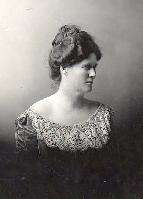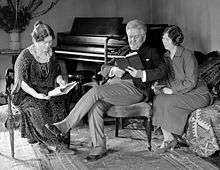Belle Case La Follette
| Belle Case La Follette | |
|---|---|
 Belle Case La Follette circa 1905 | |
| Born |
Belle Case April 21, 1859 Summit, Wisconsin, United States |
| Died |
August 18, 1931 (aged 72) Washington D.C., United States |
| Education |
University of Wisconsin-Madison University of Wisconsin Law School |
| Occupation | Lawyer and women's suffrage activist |
| Spouse(s) | Robert M. La Follette, Sr. (m. 1881–1925) |
| Children | Fola La Follette, Robert M. La Follette, Jr., Philip La Follette and Mary La Follette |
Belle Case La Follette (April 21, 1859 – August 18, 1931) was a lawyer and a women's suffrage activist in Wisconsin, United States. La Follette worked with the women's peace party during World War I. At the time of her death in 1931, the New York Times called her "probably the least known yet most influential of all the American women who had to do with public affairs in this country".
She is best remembered as the wife and helpmate of Robert “Fighting Bob” La Follette—a prominent Progressive Republican politician both in Wisconsin and on the national scene—and as co-editor with her husband of La Follette’s Weekly Magazine.[1]
Biography
Belle Case was born on April 21, 1859 in Summit, Juneau County, Wisconsin. Her parents were Unitarian of English and Scottish descent. She attended the University of Wisconsin–Madison from 1875 to 1879 and, upon graduation, taught high school in Spring Green and junior high school in Baraboo.[2] One of her students in Baraboo was John Ringling, of whom she later wrote "... when John read a long account -- interrupted with giggles from the school -- of the side shows he and other boys had been giving every night, I lectured him and drew the moral that if John would put his mind on his lessons as he did on side shows, he might yet become a scholar. Fortunately the scolding had no effect."
Marriage
She married her former classmate at the University, Robert Marion La Follette Sr., on December 31, 1881. The ceremony was performed by a Unitarian minister and by mutual agreement, the word “obey” was omitted from the marriage vows. Their first child, Flora Dodge La Follette, always called “Fola”, was born on September 10, 1882. Fola married the playwright George Middleton on October 29, 1911.
Belle Case La Follette returned to the University of Wisconsin Law School and became the school’s first woman graduate in 1885. She never practiced as an attorney but she assisted her husband and he frequently acknowledged her authorship or contribution to a brief. She supported and assisted her husband as he rose through the political offices of Dane County District Attorney, United States Representative, Governor of Wisconsin, United States Senator, and Presidential candidate.
Her other children were Robert Jr., born in 1895, who succeeded his father as Senator; Philip, born in 1897, who became Governor of Wisconsin; and Mary, born in 1899. Her sons began the Wisconsin Progressive Party, which briefly held a dominant role in Wisconsin politics.
Career

Belle lectured on women’s suffrage and other topics of the day. In 1909 she edited the “Home and Education” column in the magazine started by her husband, La Follette’s Weekly Magazine, which later became The Progressive. In 1911 and 1912 she wrote a syndicated column for the North American Press Syndicate. In 1914 Belle addressed the colored Young Men's Christian Association, raising an argument that segregation of colored people on street cars, public conveyances, and government departments was wrong. She added there would be no constitution of peace until the question is "settled right".
When suffragists made appearances at more than 70 county fairs in 1912, Belle Case visited seven of them in 10 days. In 1915 she helped found the Woman’s Peace Party, which later became the Women’s International League for Peace and Freedom. After World War I, she was active in the Women’s Committee for World Disarmament, and helped found the National Council for the Prevention of War in 1921. She and other women influenced governments to convene the Naval Arms Limitation Conference in 1922.
After her husband’s death on June 18, 1925, his seat in the United States Senate was offered to her, but she turned down the opportunity to become the first woman Senator, perhaps because it would have upset the very balance between her public and private lives that she is esteemed for.[2]
Death
She died on August 18, 1931 in Washington D.C., as the result of a punctured intestine and peritonitis following a routine medical exam.[1] She was buried in Forest Hill Cemetery in Madison.[3]
Published works
- Belle Case La Follette and Fola La Follette (1953). Robert M. La Follette, June 14, 1855-June 18, 1925, 2 volumes. MacMillan. ISBN 978-1-299-79732-1.
References
- 1 2 "Belle Case La Follette Followed Brilliant Career". The Milwaukee Journal. August 19, 1931. Retrieved 2012-10-11.
La Follette, possibly the only woman American history with the distinction of having been the wife and mother of both governors and United States senators, ...
- 1 2 "Belle Case La Follette". Wisconsin Historical Society. Retrieved 2010-07-13.
Born in Summit, Wisconsin (Juneau County), on April 21, 1859, Belle La Follette (nee Case), idolized her farmer parents who sacrificed everything to send their only daughter to college in 1875. ...
- ↑ "Wisconsin Mourns Mrs. La Follette. tate, City and County Offices at Madison Shut in Memory of Senator's Mother. All Flags At Half Staff. Professor Max Otto, at Simple Funeral Service, Terms Her a 'Part of Glowing History.'". New York Times. August 22, 1931. Retrieved 2012-10-11.
Under a huge oak tree in Forest Hills Cemetery, beside her famous husband, Mrs. Belle Case La Follette, mother of Wisconsin's Senator and Governor, was buried today.
The Afro American Ledger _ January 10, 1914
Further reading
- Freeman, Lucy and La Follette, Sherry, 'Belle: A Biography of Belle Case La Follette', 1986.
- Weisberger, Bernard A., The La Follettes of Wisconsin Love and Politics in Progressive America, The University of Wisconsin Press, 1994.